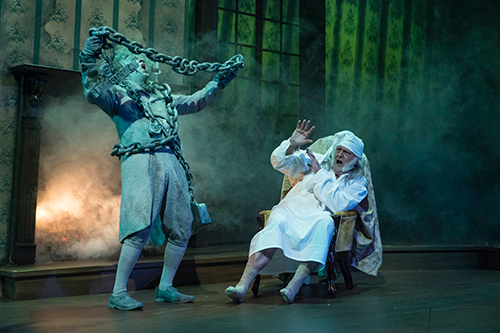Introduction
In the previous lesson, we addressed the concept of aesthetics. If you remember, aesthetics is the overall visual representation of what an audience will see on a stage. The hope is that the audience will be awed by what they see.
A designer must really consider the picture that a director is trying to paint. Read the article "How Do You Design a Fairy Tale?" from Playbill to learn more about how designing for different shows requires a different approach by designers.

The ghost of Jacob Marley confronts Scrooge in Theatre Tuscaloosa's 2017 production of the classic, A Christmas Carol. Image used with permission.
Look at the picture above from A Christmas Carol. A costume for Marley's Ghost will look different than a costume for Scrooge! Of course, Marley has been dead for seven years! In this lesson, we will learn more about the tools designers use to produce these costumes and sets.
Following successful completion of this lesson, students will be able to...
- Identify and apply the elements of design: shape, lines, color, texture, and space.
Essential Questions
- How is technical design important to the overall success of a theatrical production?
Enduring Understandings
- Technical design is an important part of the overall production of a theatrical work.
The above objectives correspond with the Alabama Course of Study: Theatre Proficient standards: 1, 2, 12.
